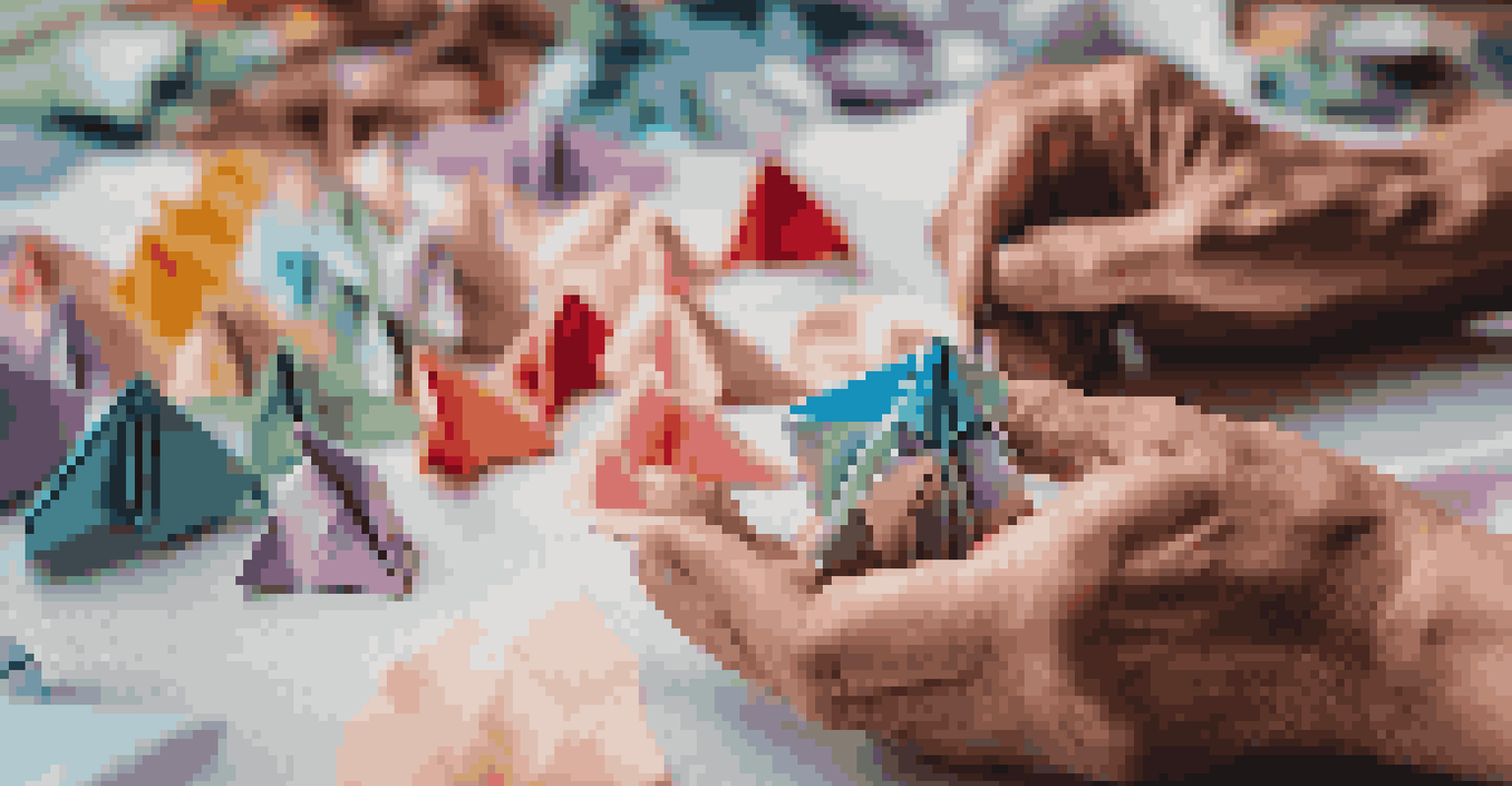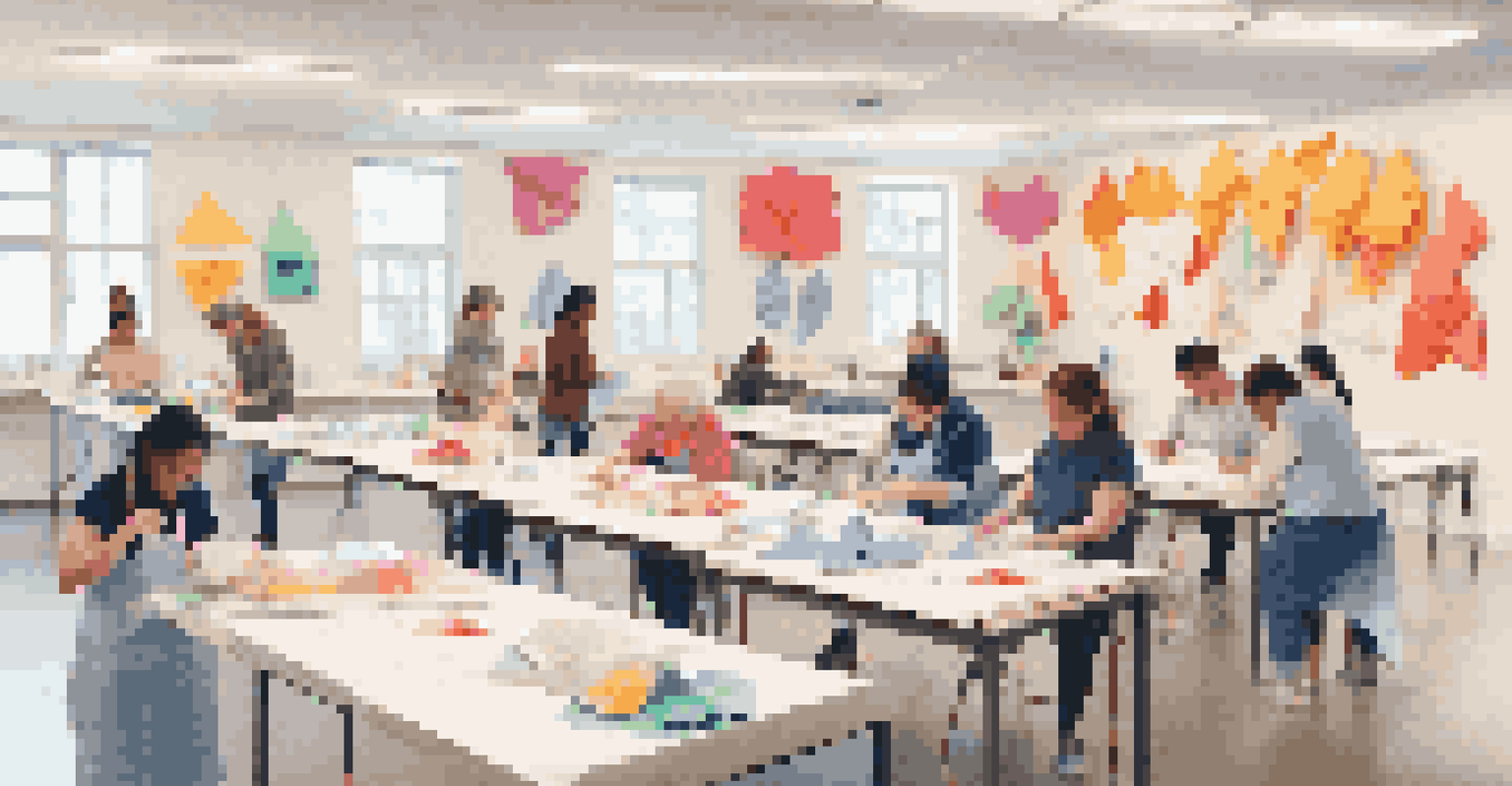Origami in Art Exhibitions: Showcasing Paper Folding Talent

The Artistic Evolution of Origami in Modern Exhibitions
Origami, the ancient art of paper folding, has evolved over the years to become a significant form of contemporary art. Today, artists experiment with intricate designs that challenge the traditional limits of paper. This evolution has led to origami being featured prominently in art exhibitions around the world, showcasing its versatility as a medium.
Origami is not just an art form; it's a way to express the intersection of creativity and mathematics.
In modern exhibitions, origami is not just about creating paper cranes or flowers; it often incorporates elements of mathematics and engineering. Artists like Robert Lang and Erik Demaine push boundaries, utilizing complex algorithms to create breathtaking sculptures. Their work illustrates how origami can bridge the gap between art and science, captivating audiences with its depth.
This artistic evolution has also sparked a renewed interest in the craft among younger generations. Workshops and community events often accompany exhibitions, inviting people to learn and appreciate the beauty of origami. As a result, origami becomes not only an art form but also a communal activity that fosters creativity and connection.
Highlighting Talented Origami Artists in Exhibitions
Art exhibitions serve as a platform for talented origami artists to showcase their skills and creativity. Each artist brings their unique perspective, often reflecting personal stories or cultural elements through their work. This diversity enriches the viewing experience, allowing audiences to connect with the art on multiple levels.

For instance, artists like Sipho Mabona and Akiyuki Miyamoto have gained recognition for their large-scale origami installations. These pieces often require meticulous planning and execution, showcasing the level of skill and dedication involved in the craft. Their work not only impresses viewers but also inspires new artists to explore the world of paper folding.
Origami Blends Art and Science
Modern origami artists incorporate mathematical principles and engineering to push the boundaries of traditional paper folding.
By highlighting these talented individuals, exhibitions can elevate the status of origami within the art community. This recognition encourages a dialogue about the importance of craftsmanship and creativity, ultimately leading to a greater appreciation for the art form as a whole.
The Impact of Origami on Cultural Exchange in Art Spaces
Origami exhibitions often serve as a unique medium for cultural exchange, bridging gaps between diverse artistic traditions. Many cultures have their own styles and techniques of paper folding, which are showcased in exhibitions. This not only educates visitors but also fosters a greater understanding and appreciation of different cultural perspectives.
The beauty of origami lies in its ability to transcend cultural boundaries and connect people through art.
For instance, Japanese origami is renowned for its precision and elegance, while Western interpretations may lean towards more abstract forms. By displaying a variety of styles, exhibitions encourage dialogue and collaboration among artists from different backgrounds. This cross-cultural interaction enriches the art community and promotes inclusivity.
Moreover, cultural exchange through origami can lead to innovative artistic collaborations. When artists from various traditions come together, they often create hybrid forms that blend techniques and aesthetics. These collaborations not only push artistic boundaries but also celebrate the beauty of diversity in creativity.
Educational Programs: Fostering Origami Skills in Art Exhibitions
Many art exhibitions are now incorporating educational programs focused on origami, aiming to engage visitors of all ages. These hands-on workshops allow participants to learn basic folding techniques, fostering a deeper connection with the art. This interactive approach enhances the overall experience, making art more accessible and enjoyable for everyone.
Workshops often feature local artists who guide participants through the process, sharing tips and tricks along the way. This personal interaction helps demystify the art form, encouraging individuals to experiment and unleash their creativity. By providing a supportive environment, these programs can ignite a passion for origami that extends beyond the exhibition.
Cultural Exchange Through Origami
Origami exhibitions facilitate cultural exchange by showcasing diverse paper folding techniques from various traditions.
Additionally, educational programs can inspire future generations to appreciate and practice origami. By instilling a sense of curiosity and creativity in young minds, exhibitions can cultivate a community of budding artists. This emphasis on education not only enriches the experience but also ensures the longevity of the art form.
The Role of Technology in Modern Origami Art
As technology continues to advance, it has begun to influence the world of origami in exciting ways. Digital tools allow artists to create and visualize complex designs that would be difficult to achieve by hand. This fusion of art and technology expands the possibilities, leading to innovative creations that captivate audiences.
For example, computer software can simulate folding patterns and generate intricate designs that challenge traditional methods. Artists can experiment with various shapes and structures, pushing the boundaries of what is possible with paper. This technological integration not only enhances creativity but also brings a fresh perspective to the art of origami.
Moreover, technology enables artists to reach a broader audience through online platforms and virtual exhibitions. This accessibility allows more people to engage with origami art and learn about its intricacies. The combination of technology and traditional craftsmanship creates a dynamic art form that continues to evolve and inspire.
Sustainable Practices in Origami Art Exhibitions
Sustainability has become a key theme in many modern art exhibitions, including those focusing on origami. Artists are increasingly using eco-friendly materials, such as recycled paper, to create their works. This commitment to sustainability not only reduces waste but also promotes awareness of environmental issues within the art community.
By incorporating sustainable practices, origami artists can inspire viewers to consider their own impact on the environment. Exhibitions often highlight the importance of using renewable resources, encouraging a shift towards more eco-conscious choices in both art and everyday life. This focus on sustainability aligns with a growing global movement towards responsible consumption and creativity.
Sustainability in Origami Art
Many origami artists are embracing eco-friendly materials, highlighting the importance of sustainability in contemporary art.
Furthermore, showcasing sustainable origami practices can lead to innovative solutions. Artists are experimenting with materials and techniques that minimize environmental impact while still producing stunning works of art. This blend of creativity and sustainability serves as a powerful reminder of the role art can play in promoting a healthier planet.
The Future of Origami in Art Exhibitions
As we look to the future, the role of origami in art exhibitions is poised to grow even more influential. With the continued evolution of techniques and materials, artists will find new ways to express their creativity through paper folding. This potential for innovation keeps audiences intrigued and eager to explore what’s next in the world of origami.
Additionally, as more artists embrace technology and sustainability, the art form will likely reflect contemporary social issues and values. This relevance will attract a diverse audience, fostering a renewed interest in origami as a significant art form. The future promises exciting possibilities for collaboration, experimentation, and artistic expression.

Ultimately, the journey of origami in art exhibitions is a testament to the enduring power of creativity. By showcasing the talents of origami artists and promoting educational initiatives, exhibitions can continue to inspire and engage audiences for years to come. As the art form evolves, it will undoubtedly leave a lasting impact on the art world and beyond.